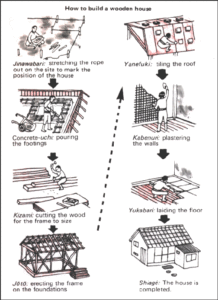Materials
A kyo-machiya even today is made from natural materials: wood, paper, straw, earth in the house; trees, water, stones, and moss in the garden. There is no distance between the material of kyo-machiya and natural things like flowers, dust, and wind. Element of nature outside influence the inside, and inside elements frame the outside. The earth and straw walls control the humidity in all weather and as a rule a small garden brings the outside to the inside the house. The concept of the house is nature itself.
Japanese interior design is very efficient in the use of resources. Traditional and modern Japanese interiors have been flexible in use and designed mostly with natural materials. The spaces are used as multifunctional rooms. The rooms can be opened to create more space for a particular occasion or for more privacy, or vice versa closed-off by pulling closed paper screens called shōji.
Japanese Zen interior designs draw inspiration from elements of nature as they have immense respect for nature. Their designs have a strong connection with natural elements such as wood, plants, natural lighting and more.
A large portion of Japanese interior walls are often made of shōji screens that can be pushed open to join two rooms together, and then close them allowing more privacy. The shōji screens are made of paper attached to thin wooden frames that roll away on a track when they are pushed. Another important feature of the shōji screen, besides privacy and seclusion, is that they allow light through. This is an important aspect to Japanese design. Paper translucent walls allow light to be diffused through the space and create light shadows and patterns.
Tatami mats are rice straw floor mats often used to cover the floor in Japan’s interiors; in modern Japanese houses there are usually only one or two tatami rooms. Another way to connect rooms in Japan’s interiors is through sliding panels made of wood and paper, like the shōji screens, or cloth. These panels are called fusuma and are used as an entire wall. They are traditionally hand painted.
Tatami are the basis of traditional Japanese architecture, regulating a building’s size and dimensions. They originated in ancient Japan when straw was laid on bare earth as a softener and warmer. In the Heian Period (794–1185), this idea developed into moveable mats that could be laid anywhere in the house to sit or sleep on before becoming a permanent floor covering in the fifteenth century.Tatami are suitable for the Japanese climate because they let air circulate around the floor.
Bamboo is prominently used and even expected in the Japanese house, used both for decorative and functional purposes. Bamboo blinds, sudare, replace shoji in summer to prevent excess heat inside and also offer greater ventilation. Country dwellings and farmhouses often use it for ceilings and rafters. The natural properties of bamboo, its raw beauty with the knots and smooth surface, correspond to Japanese aesthetic ideals of imperfection, contrast and the natural.
The use of paper, or washi, in Japanese buildings is a main component in the beauty and atmosphere of the Japanese interior, the way variation of shadow combines to create a “mystery of shadows”.A range of papers are used for various purposes in the home.
Wood is generally used for the framework of the home, but its properties are valuable in the Japanese aesthetic, namely its warmth and irregularity.
A recessed space called tokonoma is often present in traditional as well as modern Japanese living rooms. This is the focus of the room and displays Japanese art, usually a painting or calligraphy.
Today Shigeru Ban is helping many people with his innovations.


